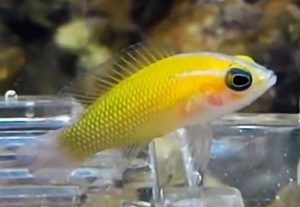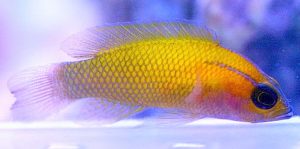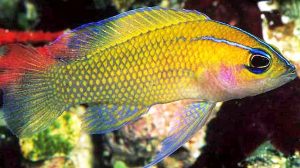The Threeline Basslet (Lipogramma trilineatum) found in the western Atlantic Ocean from the waters off S.E. Florida, south through the Bahamas, into the Gulf of Mexice and the Caribbean Sea, and along the coasts of Central and South America from Quintana Roo, Mexico to Nicaragua, and the seas off Cartagena, Venezuela at Curacao and Bonaire, is a deep water species that is rarely available to tropical fish keeping enthusiasts.
The Threeline Basslet is a shy, reclusive, carnivore that lives along the outer walls and in the deeper reefs of their range under corals and rocky ledges at depths between 70 to over 498 feet where they feed on zooplankton, small fish, and invertebrates. Even though the Threeline Basslet has been encountered in shallow waters, most of the specimens collected have been by submersibles from deep water.
The Threeline Basslet has has an elongated, compressed body with large eyes, a short snout, and a wide mouth that sits at the bottom front of the head. The upper part of the head, the back, and majority of the dorsal fin is a reddish orange to yellowish color. The yellowish scales are outlined in a greenish brown color that darkens toward the caudal peduncle and gives it a bluish gray color.
They have three thin black edged deep blue lines on the head; one directly on top that runs from the lower lip along the center of the snout into the dorsal fin, one line behind the upper eye that runs up over the front third of the body, and another short line visible just under the eye. The pelvic, anal, caudal and rear portion of the dorsal fins are a translucent pale blue with light yellow spots, and a light blue line runs along the outer margin of the dorsal fin.
Juvenile Threeline Basslets are colored similarly to adults except for the blue eye stripe that extends along the upper side to the upper end of tail base. They have an additional blue stripe that extends from the upper base of the pectoral fin to the tne of the lower part of the caudal peduncle.
Because the Threeline Basslet is collected from very deep water, they are best housed in a mature, dimly lit FOWLR or reef tank of at least 20 gallon capacity with a crushed coral substrate and plenty of live rock arranged into numerous caves, crevices, and overhangs for them to take shelter among. They are reef safe with corals but will eat small crustaceans and invertebrates if they can get them into their mouth. Because of the extreme depths they are collected from, they require low, dim lighting conditions, cool water temperatures, and pristine water quality for them to thrive. An aquarium chiller
, a good reef filtration system, and regular water changes is recommended to keep this species healthy and vibrant.
Threeline Basslets are extremely shy and will shelter in their cave or crevice most of the time. They should never be housed in a reef or FOWLR aquarium with aggressive tankmates or they could starve to death. Even with peaceful tankmates like Chromis or Dartfish, they will never become social, outgoing tankmates, and wll always stay close to their hiding area.
Lipogramma trilineatum have not been bred in an aquarium environment.
In their natural environment, Threeline Basslets feed on zooplankton, small crustaceans, and tiny fish that may venture into their territory. In an aquarium environment, they should be provided with a varied diet of fresh or frozen marine fish, finely chopped clams, Hydrozoa polyps, Mysis shrimp, enriched brine shrimp, crustacean flesh, etc. Finely chopped enriched freeze dried foods and even carnivore flake foods can also be offered to three times a day.
The Threeline Basslet is another rarely encountered deep water species that is seldom available to tropical fish keeping enthusiasts.
In addition to being difficult to catch, Lipogramma trilineatum are found at depths to over 500 feet, which is well beyond the limits of scuba divers and most rebreather divers.
Most specimens are collected by marine submersibles and decompressed in the same manner as the Golden Basslet (Liopropoma abberans). Additionally, its range has been invaded by lionfish, an invasive species in the western Atlantic, which prey on both juvenile and adult Lipogramma trilineatum.
Despite the factors that contribute to its rarity and five figure selling price; the Threeline Basslet (Lipogramma trilineatum) is occasionally available to tropical fish keeping enthusiasts on a back order basis with a 1 to 2 month lead time from a select few specialty rare fish wholesalers and retailers online at prices starting at $1,199.99.
Although it is not as elegant and graceful looking as some of the other Lipogramma species, the Threeline Basslet will continue to command a high price to anyone who is willing to pay for it.
Minimum Tank Size: 20 gallons
Aquarium Type: Reef or FOLR
Care Level: Moderate
Temperament: Peaceful
Aquarium Hardiness: Hardy
Water Conditions: 68⁰-77 °F, dKH 8 – 12°, pH 8.0 – 8.5, sg 1.020-1.026
Max size: 1.4″
Color Form: Orange, Yellow
Diet: Carnivore
Compatibility: Reef with Caution
Origin: Aruba, Curacao, Florida, Gulf of Mexico, Jamaica, Mexico (East Pacific), Puerto Rico, The Bahamas, the Netherlands Antilles, USA, West-Atlantic Ocean
Family: Grammatidae
Lifespan: 3 – 4 years
Aquarist Experience Level: Intermediate/Expert




